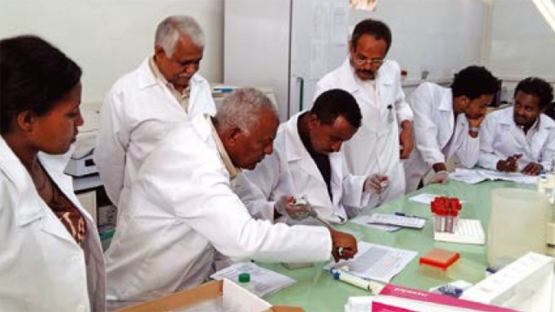In May this year the highly pathogenic avian influenza virus was for the first time ever reported in the Democratic Republic of the Congo. Despite the fact that the disease was considered exotic and had never before been experienced in this country, the national veterinary laboratory in Kinshasa, a partner in the VETLAB Network, was well prepared. Once confirmed, it immediately notified the World Organization for Animal Health and started the implementation of control measures.
When the avian influenza virus was spreading across Asia into Africa in the early 2000s, veterinary extension services gathered virus samples from the field, but often had to send them abroad for diagnosis because their national labs were not able to conduct the specific tests needed. Problems arose because they were sending live virus samples, which many airlines refused to ship. Even when airlines did agree, the costly and time-consuming shipment protocols meant diagnoses were delayed, slowing desperately needed response activities. Compare that to a suspicion of avian flu in Togo in 2015. When that arose, Togo sent its suspicious samples to a competent laboratory in neighbouring Ghana and received results quickly. This enormous advance is the result of VETLAB, a Joint FAO/IAEA Division network of veterinary diagnostic laboratories in Africa and Asia, initially established during the global effort that eradicated rinderpest – a deadly cattle disease.
VETLAB wins its first battle
A laboratory network established to connect technical expertise in the global battle against rinderpest, VETLAB was certainly in the winner’s circle when the disease was declared eradicated in 2011. The unprecedented victory against a disease that had plagued the livestock sector for millennia owed much of its success to the networking of laboratories able to use efficient nuclear-related technology to facilitate surveillance and diagnosis in the field. However, in reality, rinderpest was just one battle in the ongoing fight to prevent and control an array of transboundary animal and zoonotic diseases – diseases that not only impact animal and public health, they devastate farmers who depend on animals for their livelihoods and disrupt world food trade.
So, instead of just congratulating VETLAB for a job well done, the Joint Division not only maintained the network, it expanded its membership to other African labs and alsoto labs in Asia. Now membership includes and connects laboratories in 44 African and 19 Asian countries. The Joint Division supports them in improving their screening and diagnostic capacities, and upgrading their equipment and facilities. It also runs proficiency tests of laboratory capacity to diagnose specific diseases and conducts training to help the labs achieve accreditation from the International Standards Organization (ISO). ISO accreditation attests a lab’s expertise and capacity to perform specific laboratory tests and is required by importing countries that want assurance that animals or animal products they receive comply with global food standards.
Early diagnosis is the key element in stopping the spread of transboundary animal diseases. During the rinderpest campaign, when VETLAB members were working together in a highly focused environment, they opened valuable lines of communication, were able to share and define common needs, collaborate and reach conclusions together. Now the VETLAB networking exchange, an endeavor which evolved so naturally in VETLAB’s earlier days, remains a main fabric of the programme.
The Joint Division brings veterinary laboratory scientists together through workshops and coordination meetings, offering a unique opportunity for countries facing similar challenges to coordinate activities such as training, information dissemination and the design of disease control strategies. During a meeting of Asian laboratories, Mongolia requested technologies to test for peste des petits ruminants (PPR), a viral disease that affects small ruminants. Although the disease is not currently found in Mongolia, the country recognizes the need to be vigilant because it is bordered by countries where PPR is present.
“Leading laboratories” provide regional support
Within its membership, VETLAB identified the leading laboratories of Ethiopia, Botswana, Cameroon and Ivory Coast to provide regional support. The Joint Division specifically works with these laboratories to improve their facilities and increase the number of tests they perform so they, in turn, can conduct tests for neighboring countries with labs that have not yet received accreditation. Botswana’s National Veterinary Laboratory and Cameroon’s Laboratorie National Vétérinaire host disease diagnosis training courses for labs in the region. Cameroon tested and quickly diagnosed the swine samples sent from Chad as an African swine fever infection, a highly contagious pig disease. The rapid response enabled Chad to focus its national control measures.
As VETLAB laboratories continue to improve and expand accreditation for more diseases, there will be fewer reports of delays in diagnosis such as happened with avian flu in 2000. In fact, when avian flu appeared in Europe and Africa in 2015, technical experts from the Joint Division went to affected countries to install needed diagnostic equipment in the national laboratories and to train the staff in using it. They knew quickly what strain of flu they were dealing with and, with that information, were able to prepare proper control measures.





